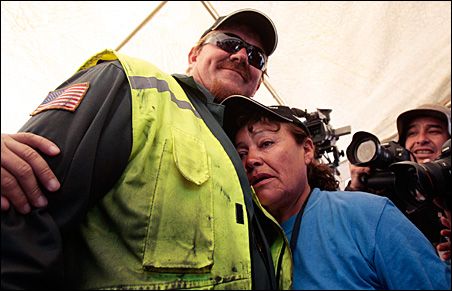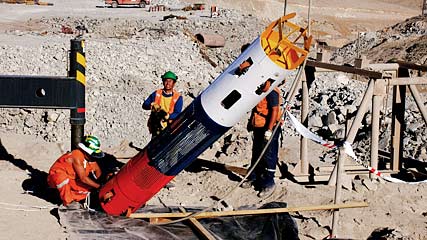The miners have been trapped 2,300 feet below ground level since August 5. They were discovered 17 days after the rockslide, and have survived until now due to rescue workers lowering water, food, medicine and other supplies down to the men.
Around this same time in late August, NASA dispatched a four-man team to the mine. The team consisted of Clinton Cragg, a NASA engineer; Michael Duncan, a doctor; James Polk, a doctor, and Al Holland, a psychologist.
Cragg began designing an escape capsule that could fit in a hole the size of a bicycle tire, and handed the finished plans to the Chilean navy, who built the capsule. The finished product was a 13-foot long, 924 pound steel rescue craft that had an escape hatch at the bottom. It was named "Fenix," after the mythical bird that rose from ashes. The Fenix capsule is very narrow, where miners have barely any room to move their shoulders, but contains a safety harness, a device to communicate with rescue teams and a clock.

Steadily, each miner is being pulled from the ground one by one inside the red, white and blue capsule. The first miner to rise from the "Fenix" was Florencio Avalos, who was greeted by chants and cheers of "Chile!" He arrived at the surface at 12:11 a.m.
"I'm overwhelmed with emotion because it's been so long since we have seen him," said Alfonso Avalos, Florencio's father. "I'm very proud of him. Thanks to God he got out and looks good."
The process has repeated itself throughout the morning, bringing each miner to safety through a half-mile of rock. It takes approximately 50 minutes to lower the capsule and bring it back up. Each miner is to wear moisture-resistant green coveralls on their ride up to the surface, and the most "fit" miners were to arrive to the surface first so they can advise rescue teams with the "technical know-how" surrounding the situation below. Those who were weakest will come out next, and finally, Luis Iribarren, the shift supervisor, will come out last. Rescue teams expect the last miner to arrive at the surface sometime Thursday morning.
Among the rescue teams, family and friends present as the miners arrive at the surface was also Chilean President Sebastian Pinera, who hugged and greeted Avalos as he stepped onto Chilean ground for the first time in over two months.
"We had promised to look until we found them," said Pinera. "We can all feel proud to be Chilean."
The miners looked relatively healthy as they walked out of the Fenix capsule. Health Minister Jaime Manalich noted that there were only minor problems associated with the miners' health, and that rescue was "going extraordinarily well so far."
At this point, just over a dozen miners have been rescued from the mine, and are being sent to a nearby hospital for medical attention before being allowed to go home to their families.
"It's extremely exciting for us," said Jeff Hart, a lead driller with the rescue team. "It's a very emotional moment for us. We worked real long and hard on that, and to actually see the capsule come through the first time through the hole that we drilled was just unbelievable."




Reader Comments
to our Newsletter